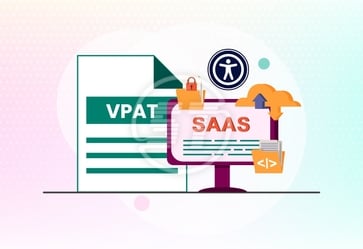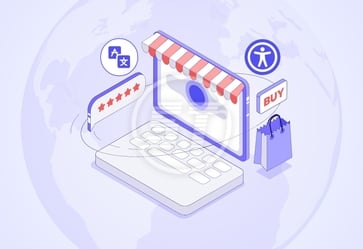Remember when making websites accessible was just about adding alt text to images? Those days are long gone. The European Accessibility Act has completely changed the game, and if you're doing business in Europe, you need to pay attention.
As of June 2025, the EAA isn't just a suggestion anymore; it's the law. And it's not just about websites. We're talking about everything from your company's mobile app to the ATM outside your office building.
101 million Europeans have some form of disability, and more than a quarter (26.8%) of people aged 16 and over in the EU had a disability in 2023. They represent a big market segment; it gives a massive opportunity to many businesses that are ignoring accessibility compliance.
What is the European Accessibility Act (EAA)?
The EAA isn't just another piece of European bureaucracy. It's actually pretty smart when you think about it. Before this law, every EU country had different accessibility rules. A German company trying to sell accessible products in France had to navigate completely different requirements.
The EAA fixes this by creating one set of rules for everyone. Here's what it does:
It standardizes accessibility requirements across all 27 EU member states. No more guessing games about what's required in each country. It also eliminates the trade barriers that different national rules created. Compliant in one EU country, compliant everywhere.
The law expands market opportunities for businesses smart enough to get ahead of the curve. And most importantly, it improves access for over 101 million people with disabilities across Europe.
According to the WHO European Region, there are at least 135 million people with disabilities in the WHO European Region. That's not just a legal requirement – it's a business opportunity that's too big to ignore.
Unlike older accessibility laws that mostly focused on government websites, the EAA is mainly about private businesses. This is a big shift that's catching a lot of companies off guard.
EAA Implementation Timeline
The European Union had until June 28, 2022, to turn the European Accessibility Act (EAA) into national law. But for businesses and organizations, the real deadline to put it into practice was June 28, 2025.
Who must comply with the EAA?
Not every business needs to worry about the EAA. There are specific thresholds that determine whether you're in or out.
The Size Test
Your business needs to comply if you have at least 10 employees AND your annual turnover is above €2 million. Note that both conditions must be met.
This means small businesses with fewer than 10 employees get a pass, even if they're making good money. Microenterprises below the €2 million revenue threshold are also exempt, regardless of how many people work there.
But if you're a medium or large business hitting both thresholds, you can't ignore this anymore.
Geography Matters Too
Here's where it gets interesting. The EAA doesn't care where your business is located – it cares where your customers are.
If you're a UK company selling to EU customers, you still need to comply. Same goes for US businesses, Canadian companies, or anyone else serving the EU market. Global companies operating in Europe definitely can't ignore these requirements.
Private vs. Public Sector
Most accessibility laws in the past targeted government organizations. The EAA flips this on its head by focusing primarily on private companies. This shift has left many businesses scrambling to understand what they need to do.
Industries and Services Covered Under the EAA
Digital Services and Ecommerce
If you’re running any kind of online business, pay close attention. The EAA covers:
- E-commerce websites and online marketplaces
- Mobile applications for shopping and services
- Digital content platforms and media streaming services
- Online booking systems and reservation platforms
Consumer Electronics and Hardware
The EAA mandates that a range of products, such as consumer electronics (TVs, smartphones, computers, gaming consoles, etc.), comply with accessibility requirements. This includes:
- Smartphones and tablets with accessible operating systems
- Computers and laptops with disability-friendly interfaces
- Smart TVs with audio descriptions and captioning capabilities
- Gaming consoles with accessible control options
Banking and Financial Services
Financial services face comprehensive accessibility requirements covering:
- Online banking platforms with screen reader compatibility
- ATMs and payment terminals with audio guidance and tactile features
- Mobile banking apps with voice control and high contrast modes
- Customer service portals with accessible help documentation
Transportation and Travel
Businesses offering travel services related to air, bus, rail, etc., having websites and mobile applications, should adhere to accessibility standards mentioned in the EAA. This means:
- Airline booking websites must offer accessible flight search and booking
- Train and bus company platforms need clear journey planning tools
- Travel booking apps must provide accessible payment and confirmation processes
- Electronic ticketing systems require compatibility with assistive technologies
Self-Service Terminals and Kiosks
Ticketing and vending machines must now meet accessibility standards, including:
- ATM machines with audio instructions and Braille keypads
- Ticket vending machines at transport hubs with voice guidance
- Information kiosks in airports and shopping centers
- Self-checkout terminals in retail stores
Telecommunications
Communication services and devices must provide accessible options:
- Phone services with hearing aid compatibility
- Internet services with accessible customer portals
- Video calling platforms with captioning and sign language support
- Messaging apps with screen reader compatibility
Businesses and Aspects NOT Covered by the EAA
EAA has excluded the following from its ambit:
- Microenterprises (under 10 employees or €2 million revenue)
- Content created before June 28, 2025 (with some exceptions)
- Certain medical devices and specialized equipment
- Time-based media published before the compliance date
Key Compliance Requirements and Standards
Overview of Technical Standards
The EAA requires the businesses to meet the need for digital accessibility standards like WCAG 2.1 (Level AA) and EN 301 549. It also emphasizes the POUR principles.
For businesses looking to understand these technical requirements, Skynet Technologies' accessibility provides comprehensive guidance on implementing EN 301 549 compliance and meeting EAA requirements.
Implementation Requirements
Apart from technical standards, businesses must also offer:
- Accessibility statements detailing compliance efforts
- User feedback mechanisms for reporting accessibility issues
- Regular testing and monitoring to maintain compliance
- Staff training for accessibility best practices
Allying a comprehensive accessibility solution, such as the All in One Accessibility widget, into the mix creates a smooth path for compliance, monitoring, and support to the business on an ongoing basis.
Consequences of Non-Compliance
Not adhering to the EAA standards might have serious implications, such as,
Legal Penalties and Fines
Not following the EAA rules can lead to serious consequences. These include penalties and fines. The fines can go up to €20,000 for each violation. Legal action is also possible.
Business Impact
Besides legal action and fines, the negative impact that noncompliance exerts on business includes:
- Market access restrictions in EU countries
- Competitive disadvantage against accessible competitors
- Reputational damage from accessibility lawsuits
- Lost revenue from excluded customer segments
Steps to assess your EAA compliance status
To determine if your business needs to comply and assess status:
1. Check your business size and revenue
- Do you own a business with ten or more employees?
- Is your business's annual revenue €2 million or more?
- Does your business serve EU customers?
2. Identify covered products and services
- Review the EAA scope against your offerings
- List all customer-facing digital touchpoints
- Document physical products and self-service terminals
3. Conduct an accessibility audit
- Test your website with screen readers
- Check mobile app compatibility with assistive technologies
- Review the color contrast and text sizing options
- Evaluate keyboard navigation functionality
4. Develop an implementation plan
- You must prioritize accessibility improvements that have a significant impact
- To achieve effective outcomes, realistic compliance timelines must be established
- Allocate budget for necessary changes
- Plan staff training and awareness programs
5. Establish ongoing monitoring
- Implement regular accessibility testing
- Create user feedback channels
- Schedule periodic compliance reviews
- Stay updated on standard changes
Skynet Technologies offers comprehensive EAA website accessibility compliance services that include the following: automated testing, manual audits, and ongoing monitoring to ensure compliance.
Wrapping Up
With over 135 million people with disabilities in the WHO European Region, businesses that embrace accessibility requirements won't just meet legal obligations; they'll gain a real competitive advantage.
EAA covers businesses from e-commerce websites to ATMs, from mobile apps to self-service kiosks. The basic requirement is that you have 10 or more employees and an annual revenue above €2 million. To these businesses, compliance isn’t optional.
Furthermore, making a website accessible enables business to reach more people, improves how users interact with the site, and shows the company cares about everyone. This is why you should opt for an expert who understands it.
Skynet Technologies offers comprehensive accessibility solutions that work in the real world. Here’s what we offer:
- All in One Accessibility® widget is an advanced AI-powered solution that handles a lot of heavy lifting and improves accessibility for websites and applications.
- Accessibility compliance audit: We provide EN 301 549 compliance auditing with comprehensive assessments that align with EAA. Our audits are extensive and let you know what needs to be fixed.
- Our WCAG 2.1 & 2.2 remediation services ensure that your digital assets meet all the accessibility requirements.
- For those who use WordPress, we have special tools to make sites accessible. We offer our plugin made just for WordPress websites.
Ready to begin?
Don't let EAA compliance stymie your business progress. Contact us today for a comprehensive evaluation of your digital products and services.


